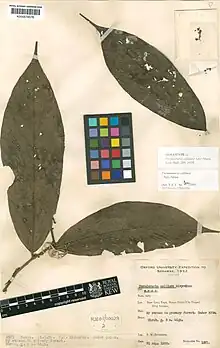Pseuduvaria calliura
Pseuduvaria calliura is a species of plant in the family Annonaceae. It is endemic to Borneo.[1] Herbert Kenneth Airy Shaw, the English botanist who first formally described the species, named it after the beautiful tails (Latinized forms of Greek καλλι, calli-; and ουρα, ura) or tips of its leaves.[3]
| Pseuduvaria calliura | |
|---|---|
 | |
| Herbarium specimen of Pseuduvaria calliura.[1] | |
| Scientific classification | |
| Kingdom: | Plantae |
| Clade: | Tracheophytes |
| Clade: | Angiosperms |
| Clade: | Magnoliids |
| Order: | Magnoliales |
| Family: | Annonaceae |
| Genus: | Pseuduvaria |
| Species: | P. calliura |
| Binomial name | |
| Pseuduvaria calliura | |
Description
It is a tree reaching 10 meters in height. Its branches have sparse lenticels. Its mildly leathery leaves are 15.5-19 by 4.5-6.5 centimeters. The tips of the leaves come to a distinctive 35-50 millimeter long point. The leaves are hairless on their upper surface and densely hairy on their lower surface. The leaves have 12-16 pairs of secondary veins emanating from their midribs. Its densely hairy petioles are 4-8 millimeters long with a groove on their upper side. Inflorescences are organized on short, inconspicuous peduncles. Each inflorescence has 1 flower. Each flower is on a densely hairy pedicel 4-8 millimeters in length. The flowers unisexual. Its flowers have 3 sepals, 0.7-1 by 1-1.5 millimeters, that are partially fused at their base. The sepals are smooth on their upper surface, sparsely hairy on their lower surface, and have fine hairs on their margins. Its 6 petals are arranged in two rows of 3. The outer oval-shaped petals are 1.5 by 1.5-2 millimeters with smooth upper surfaces and sparsely hairy lower surfaces. The inner petals have a 2 millimeter long claw at their base and a 3.5-4 by 2.5-3 millimeter blade. The inner petals are sparsely hairy on their upper surface and densely hairy on their lower surface. Each inner petal has a horizontal, rod-shaped gland at the base of its outer surface. Male flowers have up to 24 stamens that are 0.6-0.7 millimeters long. Fruit are on sparsely hairy pedicels 7-12 millimeters in length. The fruit consists of up to 7 monocarps. Each mature monocarp is a 9-13 by 10 millimeter globe. The mature monocarps are green, wrinkly and hairy.[4][5]
Reproductive biology
The pollen of P. calliura is shed as permanent tetrads.[5]
References
- "Pseuduvaria calliura Airy Shaw". Plants of the World Online. The Trustees of the Royal Botanic Gardens, Kew. n.d. Retrieved May 28, 2019.
- Julia, S. (2019). "Pseuduvaria calliura". IUCN Red List of Threatened Species. 2019: e.T137471017A137471092. doi:10.2305/IUCN.UK.2019-3.RLTS.T137471017A137471092.en. Retrieved 19 November 2021.
- Stearn, William (2004). Botanical Latin. Portland, Ore. Newton Abbot: Timber Press David & Charles. ISBN 9780881926279.
- Airy-Shaw, H. K. (1939). "Additions to the Flora of Borneo and Other Malay Islands: XII. The Annonaceae of the Oxford University Expedition to Sarawak, 1932". Bulletin of Miscellaneous Information (Royal Gardens, Kew). 1939 (6): 275. doi:10.2307/4111738. ISSN 0366-4457. JSTOR 4111738.
- Su, Yvonne C.F.; Saunders, Richard M.K. (2006). Monograph of Pseuduvaria (Annonaceae). Systematic Botany Monographs. Vol. 79. American Society of Plant Taxonomists. pp. 1–204. JSTOR 25027955.
